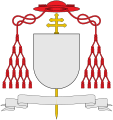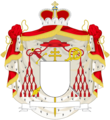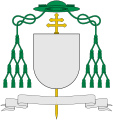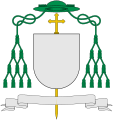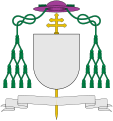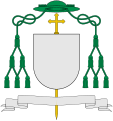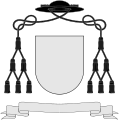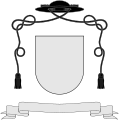Ecclesiastical heraldry
From the 12th century, under the influence of the secular, a separate church heraldry emerged . The Heraldry of the Church renounced the secular symbol of the helmet and used instead hat and cross. A heraldic style of its own has developed up to the present day .
History and Development
The oldest known episcopal coat of arms belonged to Guillaume de Joinville , who was Bishop of Langres between 1209 and 1215. A generation later there was the first Zurich coat of arms with heraldic flags of bellicose bishops. The bishops did not have coats of arms, because all priests were strictly forbidden to fight. Nevertheless, coats of arms emerged around 1250 that were very similar to those of the knights.
In the late Middle Ages , this art entered a decadent period and it used secular signs such as the sword and crown . The secularization of the prince-bishop counties and duchies and a reconsideration, with the later Pope John XXIII. and whose friend and colleague Archbishop Bruno Bernhard Heim played an important role, brought about a new, purely ecclesiastical heraldry. On the other hand, the capital letter M (for Maria ) in the coat of arms of John Paul II is seen as an elementary violation of heraldic aesthetics.
In recent times, ecclesiastical heraldry has been striving for a general simplification.
In church heraldry, Christian-religious insignia have always been used instead of the helmet , the helmet cover and the crest of a coat of arms . During the Baroque period it was also quite common to replace the frowned upon knight helmet with a skull .
Heraldry in the Roman Catholic Church today
Church heraldry insignia
-
cross
- simple lecture cross - bishop, archbishop (honorary)
- double lecture cross (often also called "patriarchal cross") - archbishop of a (titular) archbishopric
- triple lecture cross - papal cross
- Crook
- with (also without) Pannisellus - abbots and abbesses
- Cardinal Chamberlain during the vacancy
-
Pallium
- with red crosses - Pope (first time: Benedict XVI.)
- with black crosses - Metropolitan (head of an ecclesiastical province), occasionally awarded to other (arch) bishops
- Galero ("clerical hat") - all priests and bishops (except the Pope)
- Tassels (fiocchi) in different numbers and colors, they largely determine the rank
- Key - Pope, in case of vacancy: Cardinal Chamberlain
- Tiara - Pope
- Tiara miter (a miter with three implied crown rings) - Pope
Coat of arms of church dignitaries
The insignia that are currently still in use include the broad-brimmed prelate's hat (the galero ), shepherd's staff with or without a pannisellus , a pallium and lecture crosses . The hats show the rank of the coat of arms in the ecclesiastical hierarchy through their color and the decoration of tassels. A cardinal may wear a red hat with 30 red tassels (fiocchi) in the coat of arms. A patriarch has instead to make it a green hat and also 30 tassels in green, which are interwoven possibly with gold from the trappings of Archbishop Primate to distinguish (in Green) (a rather theoretical difference, as the primates crest today just as that of the archbishops are timbre, and many patriarchs of the Latin rite are also cardinals and as such wear their coats of arms). The Primate Germaniae, the Archbishop of Salzburg , has legate purple as Legatus Natus in his archbishop's coat of arms. An archbishop wears a green hat with 20 tassels, a bishop , an abbot of a territorial abbey or a prelate of a territorial prelature also wears a green hat, but only with 12 tassels. In the Chinese culture, the green hat of the bishops is often replaced by a purple hat, since in Chinese a cuckold is literally called the wearer of the green hat .
Even below the rank of bishop, clergymen are entitled to use coats of arms. The apostolic protonotaries timbre it with a violet galero, which has 12 such tassels on crimson strings, the titular protonotaries (above all, all vicars general who have not yet been awarded an honorary prelature) wear a black hat with 12 black tassels on them Lace. Honorary prelates meet in a purple hat with 12 purple tassels, the chaplains of His Holiness ("Monsignore") are entitled to a black hat with 12 purple tassels on such cords.
The secular clergy at the diocesan level continues this system - albeit entirely in black. Provosts , cathedral capitulars and other canons , sometimes also general or archdeaners , wear a black galero with six tassels, deans (in some areas also the pastors) wear a galero with four tassels.
In the religious clergy, the superiors general - like the titular protonotaries - wear a black galero with 12 tassels, the provincials one with six tassels, the local superiors (priors etc.) one with four tassels. The coats of arms of the archabbots , abbots and the provosts with benedictions wear a black galero or one in the color of the order with six tassels with abbot's staff or sometimes instead of the galero the miter above the shield, an abbot general or abbot primate wear a galero with 12 tassels and behind the shield a shepherd's crook with a handkerchief. An abbess often places the crook with a pannisellus behind the coat of arms.
All other priests (and possibly also deacons) keep a black galero with two black tassels.
The Pope is the only ecclesiastical dignitary who has the right to wear a crown , the tiara , in his coat of arms. He puts them on or over his coat of arms. In the time of the sedis vacancy , the time between the death of a pope and the appointment of a successor, a cardinal as camerlengo (also known as the cardinal chamberlain) conducts the Vatican state affairs. During this time, as a sign of his worldly power, he was permitted to wield an ombrellino (a round ornate umbrella) with both Peter's keys and the insignia of a cardinal in his coat of arms.
From a certain hierarchical level a clergyman had to choose a coat of arms. That was the case , at the latest, when keeping your own certificate seal. Since noble origin was not a prerequisite for attaining the highest offices in the church , it happened that priests did not have their own traditional coat of arms. For example, some popes added that of the religious congregation to which they came to their coat of arms . So among others Benedict XIII. from the Dominican order , Pius VII. from the Benedictine order or Gregory XVI. from the Camaldolese order .
Other coats of arms
The coats of arms of dioceses , archbishopric or abbeys are now usually covered by a miter . The earlier use of the miter in the personal coats of arms of the respective ordinaries is not expressly forbidden, but has in fact been out of use.
Overview of the coats of arms of church dignitaries
Pope
to 1A: Although Paul VI . 1964 put down the tiara , his successors up to and including John Paul II kept it in their coat of arms . The crown, also known as the Triregnum, with its three crown rings symbolizes the ordination office , the jurisdiction and the teaching post of the pontiff .
to 1B: Pope Benedict XVI. replaced the papal tiara with a miter , which, however, has the three crowns of a tiara and thus also symbolizes the three powers of the Pope. He has also added the pallium , the symbol of dignity of the metropolitans, to his official coat of arms, but with red and not black crosses. The color refers to the Christian martyrs . Pope Francis adopted the miter, but dispensed with the pallium in his coat of arms.
cardinal
Cardinals' coats of arms are:
2H Coat of arms of a cardinal with the dignity / function of a Prince Archbishop
Re 2A: During the period of the Sedis vacancy (i.e. until the election of a new Pope), the Cardinal Chamberlain is responsible for state affairs, and as a sign of his power, in addition to the cardinal's usual insignia, he carries the keys of Peter and the ombrellino, a kind of umbrella, in his coat of arms. Example: The coat of arms of Cardinal Camerlengo Eduardo Martínez Somalo at the 2005 Sedis vacancy.
to 2B: The coat of arms shows both the double lecture cross of an archbishop and the pallium of the metropolitan . In Germany a. a. Reinhard Cardinal Marx , the Archbishop of Munich and Freising.
Re 2C: The double lecture cross identifies the cardinal as archbishop (for example in the case of curia cardinals who were usually previously titular archbishop, but not metropolitan). E.g. Cardinal Emeritus Paul Josef Cardinal Cordes , Rome.
Re 2D: The simple lecture cross marks cardinals who preside over or have presided over a ( titular ) diocese . Examples from Germany are the first bishop of Essen , Franz Cardinal Hengsbach , and the Mainz bishops Hermann Cardinal Volk and Karl Cardinal Lehmann .
Re 2E: If priests are appointed cardinal without episcopal ordination, they should be ordained episcopal at the same time. In individual cases (e.g. old age) the Pope can dispense with it (as happened with Theodulf Cardinal Mertel , Leo Cardinal Scheffczyk or Karl Josef Cardinal Becker SJ). These cardinals do not have a lecture cross in their coat of arms.
ad 2F: Cardinal of the Curia, who is head of the order and is appointed by the Pope. The current incumbent is Edwin Frederick Cardinal O'Brien .
to 2G: Bearer of the Grand Cross of Honor and Devotion of the Order of Malta with the degree of Bailli. For example, the coat of arms of the Archpriest Emeritus of the Basilica of St. Paul Outside the Walls, Cardinal Andrea Cardinal Cordero Lanza di Montezemolo , Rome.
Patriarchs and Primates
Coats of arms of patriarchs and primates are:
|
|
Special case: |
|
to 3A: Like archbishops with cardinal rank, only in green. The tassels can be wound with gold. Example: The coat of arms of the Latin Patriarch of Jerusalem , Fuad Twal .
to 3B: Most primates have their archbishop's or cardinal coat of arms. An example of the coat of arms of a primate is that of the emeritus primate of Poland Henryk Muszyński .
to 3C: The Patriarch of Lisbon timbred until 1946 because of a privilege granted by Pope Clement XII. was granted his shield with the papal tiara , but without the papal key. Example: The coat of arms of em, who died in 1977. Patriarch Manuel Gonçalves Cerejeira of Lisbon in different designs.
Archbishops
Archbishops' coats of arms are:
|
|
Special cases: |
|
to 4A: coat of arms of an archbishop with a religious hat and 10 green tassels each, as well as a double lecture cross . Example: The coat of arms of the Archbishop of Luxembourg, Jean-Claude Hollerich .
to 4B: coat of arms of an archbishop additionally with pallium as a sign of dignity for the additional office of a metropolitan. In Germany z. B. the archbishops Hans-Josef Becker of Paderborn and Ludwig Schick of Bamberg.
Re 4C: If the title of archbishop is awarded ad personam on a honorary basis and the bishop keeps his (titular) diocese per hac vice , he wears the ten tassels, but only the simple lecture cross. Example: Archbishop and Bishop of Regensburg Michael Buchberger, who died in 1961 . As a reminiscence of the former status of an archbishopric, the bishops of Trier also traditionally wield 10 tassels, although they are not archbishops ad personam .
to 4D: The Archbishop of Udine wears the inside of the Galero in red and thus refers to his (historical) right to wear the legacy purple.
to 4E: Salzburg: The Primate Germaniae (Archbishop and Metropolitan of Salzburg) timbres his archbishop's coat of arms as Legatus natus in purple. Behind the escutcheon is either the simple legacy cross or the archbishop's double cross, combinations were also common. As an example the coat of arms of the former Primate Germaniae, Legatus natus and Metropolitan Archbishop of Salzburg Alois Kothgasser SDB.
Bishops
Coats of arms of bishops are:
5D coat of arms of a prince-bishop
Re 5A: In the past, it was customary to adorn a bishop's coat of arms with a miter and a shepherd's staff , this is prohibited by the instruction Ut sive sollicite of March 31, 1969, although exceptions occur again today. Examples of episcopal coats of arms in German-speaking countries: Karl-Heinz Wiesemann , Bishop of Speyer (Germany), Markus Büchel, Bishop of St. Gallen (Switzerland), and Klaus Küng , Bishop of St. Pölten (Austria).
Re 5B: In addition to the spiritual hat and tassels (fiocchi), the bishops of the Catholic United Churches wear an oriental miter, an oriental shepherd's crook and the coat in the coat of arms (example: the coat of arms of the Apostolic Exarch of the Ruthenian Greek Catholic Church in the Czech Republic shown here Ladislav Hučko ). The color of the hat and the number of Fiocchi correspond to the respective rank of the dignitary.
Re 5C: The abbots nullius (erg. dioecesis) are allowed to carry the spiritual insignia in green as a sign of their teaching and pastoral (but not consecration) power, similar to the bishops, but instead of the episcopal lecture cross, the crook with a waving strip of cloth, the pannisellus . In Austria z. B. the Cistercian Abbot of Wettingen-Mehrerau, Anselm van der Linde . However, if they have received episcopal ordination (→ Abbot Bishop ), they can also bear the coat of arms of a bishop, e.g. B. the martyr and former Abbot Bishop of Tokwon (North Korea) Bonifaz Sauer OSB .
Papal honorary title
6A coat of arms of a prelate ( di fiocchetto )
To 6A: The coat of arms of a prelate di fiocchetto had ten red tassels twice. These dignities have been given since the reform of the Curia under Pope Paul VI. Heraldically no longer awarded (these included the vice camerlengo, the general auditor and the general thesaurus of the Apostolic Chamber as well as the chief courtier of His Holiness), as far as they still exist as an office (such as the almsman ), they are mostly held by a titular archbishop and then designed heraldically accordingly.
To 6B: There is no difference in the coat of arms of the Apostolic Protonotare de numero participantium (= real) and the superfluous (i.e. extraordinary). This title was rarely awarded compared to the other papal honorary prelatures. Like all prelates, it has six tassels twice in the coat of arms, the spiritual hat in violet (marked as papal prelate), the tassels in red (marked as protonotary). In 2014 Pope Francis ended the award of the honorary title.
ad 6C: The tassels of an honorary prelate of His Holiness are carried in purple. In 2014, Pope Francis ended the assignment of the title outside the Roman Curia.
To 6D: The chaplain of His Holiness is not a prelate, but is also awarded by the Pope. In contrast to that of an honorary prelate of His Holiness, the spiritual hat is black. In the German-speaking world, the chaplain of His Holiness is usually referred to as Monsignore (Msgr.). Since 2014, the rank of monsignor as an honorary title has only been awarded to deserving clergy from the age of 65.
Abbots and superiors
Coats of arms of abbots and superiors are:
to 7A: General superior or highest representatives of some orders lead as an increase to the conventional coat of arms of an abbot 10 instead of the usual 6 Fiocchi. One example is the Abbot Primate of the Benedictines, Notker Wolf OSB . In the case of superiors general without ordination, the abbot's staff behind the coat of arms is not applicable.
to 7B: Uses the crook with pannisellus in the coat of arms as a sign that he has the privilege of using the pontificals in worship like a bishop . Examples: coat of arms of the Archabbot of Beuron, Tutilo Burger OSB; Coat of arms of Abbot Markus Spanier OSB from Marienberg, South Tyrol; Coat of arms of Provost Bernhard Backovsky CanReg from Klosterneuburg Monastery, Austria.
to 7C: The abbots of the Premonstratensians wear the clergy's hat, the cords and the tassels in the color of the white vestment ; B. the abbot of Duisburg-Hamborn, Albert Dölken O.Praem.
To 7D: The Grand Master of the German Order shows the clerical hat in black, the cords and tassels in the color of the order's coat, namely in white. Miter, sword and crook frame the coat of arms. Example: The coat of arms of the Grand Master Abbot Bruno Platter OT , Vienna. A prior of the Teutonic Order wears only the black hat with white strings and six tassels each.
to 7E: The head of the Order of Malta has the diplomatic rank of cardinal . However, since he is not consecrated, he has no right to participate in the conclave. Example: The coat of arms of Grand Master Matthew Festing , Rome
to 7F: see above
Priests and deacons
Coats of arms of priests and deacons are:
to 8B -general are as titular Proto notaries ex officio called prelates in Nigris (ie: in black ). This prelature is heraldically superseded by papal honorary titles (prelate or protonotary).
to 8C: Canons occasionally use other forms based on certain privileges that were granted to their chapter. Regular canons wear hats, cords and tassels in their order colors (example of German orders: black hat, white cords and tassels)
Re 8D: In the alternative design of the dean , dean or prior coat of arms , two tassels are arranged side by side.
More coats of arms
to 9A: The black rosary behind the coat of arms indicates the membership of an order . For the Knights of Professions of the Order of Malta, the shield is placed with the Maltese cross and surrounded by a rosary. Religious priests with perpetual profession timbre their coat of arms with a galero corresponding to their rank , while the professed knights use a knight helmet. Exceptions are the prince grand priors of Bohemia and those of Austria, who have the right to use a prince's hat in their coat of arms through imperial privilege.
to 9B: Abbesses carry an oval shield which is surrounded by a rosary. Behind the shield the crook as an insignia . However, since women do not belong to the clergy , both the miter and the galero are usually missing.
Heraldry in the Anglican Church
The bishops and archbishops of the Anglican Church use episcopal coats of arms similar to those of the Roman Catholic Church, but the use of the gallery in episcopal coats of arms is rather uncommon. Rather, the heraldic shield is covered by the miter.
The lower clergy of the Anglican Church did not have any spiritual coats of arms until well into the 19th century, but clerics who were entitled to coats of arms wore their inherited or lent family coats of arms. However, in the course of the Anglo-Catholic movement, this was viewed as inappropriate, so that towards the end of the 19th century, the clergy became the custom of adopting the church heraldry of Catholics with minor changes, but mainly due to the lack of hierarchical gradations, greatly simplified. In general, Anglican priests now usually timbre their coat of arms with a black galero with two black tassels (often on black and white patterned cords), only the deans and canons of the cathedral chapters usually have a black galero with six red tassels on such cords.
Further
literature
- Simon Petrus O.Praem .: Heraldic Handbook of the Catholic Church . Battenberg, Regenstauf 2016, ISBN 978-3-86646-128-4 .
- Claus Pencil Steiner: Ecclesiastical Heraldry in Bavaria: The coats of arms of the archbishops and bishops since 1817 . 2nd Edition. Degener & Co., Neustadt a. d. Aisch 1986, ISBN 3-7686-7009-0 .
- Bruno Bernhard Heim : Coat of Arms Customs and Law in the Church. Walter, Olten 1947, DNB 451904214 .
- Ottfried Neubecker : Heraldry: Coat of Arms - Your Origin Meaning and Value . Battenberg, Augsburg 1990, ISBN 3-89441-275-5 .
- Dietrich Wehner: Bishop's coat of arms - continuity and change. The development of the ecclesiastical coat of arms from the end of the imperial church to the present day, illustrated by the example of the bishops of the five original dioceses of the Upper Rhine church province. Diss., University of Osnabrück 2006, urn : nbn: de: gbv: 700-2006122918 .
Web links
- Bernhard Peter: Heraldry of the Roman Catholic Church. In: Welt-der-Wappen.de.
- Further reading on the subject of church heraldry. In: titan.bsz-bw.de. Library service center , archived from the original on September 29, 2007 (further literature on the subject at the BSZ).
Individual evidence
- ^ [1] , coat of arms of Cardinal Chamberlain Eduardo Cardinal Martínez Somalo during the vacancy of the Apostolic See in 2005.
- ^ Coat of arms of Karl Cardinal Lehmann , Bishop of Mainz.
- ↑ [2] , Coat of Arms of the Latin Patriarch of Jerusalem, Fuad Twal.
- ↑ Cardenales en el Congreso Eucarístico Internacional de Buenos Aires (4 de 6) - Escudo del cardenal Gonçalves Cerejeira , coat of arms of the former Patriarch of Lisbon Manuel Gonçalves Cerejeira (1929–1971; † 1977) in various designs.
- ^ [3] , coat of arms of the personal archbishop and bishop of Regensburg Michael Buchberger († 1961).
- ^ [4] , coat of arms of Stephan Ackermann, Bishop of Trier.
- ↑ Secrétairerie d'Etat, instruction, Ut sive sollicite n. 61 Acta apostolicae Sedis (1969).
- ↑ Episcopal coat of arms . Blazon. In: bistum-stgallen.ch. Diocese of St. Gallen , archived from the original on June 6, 2014 ; Retrieved on July 25, 2019 (coat of arms of Markus Büchel, Bishop of St. Gallen).
- ^ [5] , coat of arms of the territorial abbot Anselm van der Linde OCist von Wettingen-Mehrerau.
- ↑ Pope abolishes career titles. In: Der Tagesspiegel . January 6, 2014, accessed April 14, 2019.
- ↑ [6] , coat of arms of the Abbot Primate and Abbot of the Primatial Abbey of St. Anselmo Notker Wolf OSB in Rome.
- ^ [7] , coat of arms of the provost Bernhard Backovsky CanReg von Klosterneuburg.





